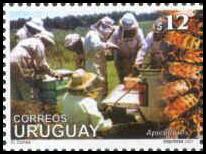The influence of insecticides commonly used for agricultural purposes on beehive depopulation in Uruguay was investigated. Honeycombs, bees, honey and propolis from depopulated hives were analyzed for pesticide residues, whereas from active beehives only honey and propolis were evaluated. A total of 37 samples were analyzed, representing 14,800 beehives. In depopulated beehives only imidacloprid and fipronil were detected and in active beehives endosulfan, coumaphos, cypermethrin, ethion and chlorpyrifos were found. Coumaphos was present in the highest concentrations, around 1,000 microg/kg, in all the propolis samples from active beehives. Regarding depopulated beehives, the mean levels of imidacloprid found in honeycomb (377 microg/kg, Standard Deviation: 118) and propolis (60 microg/kg, Standard Deviation: 57) are higher than those described to produce bee disorientation and fipronil levels detected in bees (150 and 170 microg/kg) are toxic per se. The other insecticides found can affect the global fitness of the bees causing weakness and a decrease in their overall productivity.
Source:
Lucía Pareja, Marcos Colazzo, Andrés Pérez-Parada, Silvina Niell, Leonidas Carrasco-Letelier, Natalia Besil, María Verónica Cesio and Horacio Heinzen. Int. J. Environ. Res. Public Health 2011, 8, 3844-3858; doi:10.3390/ijerph8103844
Please see POWER POINT presentation from Brian Eitzer and Kimberly Stoner from Connecticut: Dept of Analytical Chemistry,
The Connecticut Agricultural Experiment Station
Department of Entomology
Jenkins Building
123 Huntington Street
P.O. Box 1106
New Haven, CT 06504-1106
http://www.ct.gov/caes/lib/caes/documents/plant_science_day/plant_scien…

- Log in to post comments
